For the 2025 school year, there is 1 public charter school serving 73 students in Hertford County Schools School District. This district's average charter testing ranking is 3/10, which is in the bottom 50% of public charter schools in North Carolina.
ÎÛÎÛÂþ» Charter School in Hertford County School School District have an average math proficiency score of 50% (versus the North Carolina public charter school average of 55%), and reading proficiency score of 30% (versus the 59% statewide average).
Minority enrollment is 96% of the student body (majority Black), which is more than the North Carolina public charter school average of 53% (majority Black).
Overview
This School District
This State (NC)
# Schools
7 Schools
231 Schools
# Students
2,441 Students
146,602 Students
# Teachers
162 Teachers
8,664 Teachers
Student : Teacher Ratio
15:1
15:1
District Rank
Hertford County Schools School District, which is ranked within the bottom 50% of all 320 school districts in North Carolina (based off of combined math and reading proficiency testing data) for the 2021-2022 school year.
The school district's graduation rate of 75-79% has decreased from 82% over five school years.
Overall District Rank
#300 out of 325 school districts
(Bottom 50%)
(Bottom 50%)

Math Test Scores (% Proficient)
20%
51%
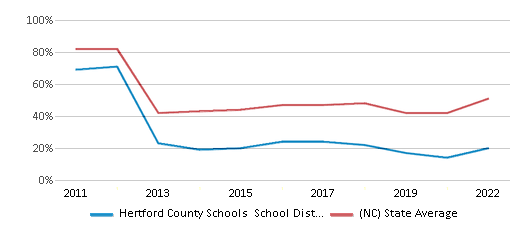
Reading/Language Arts Test Scores (% Proficient)
30%
50%
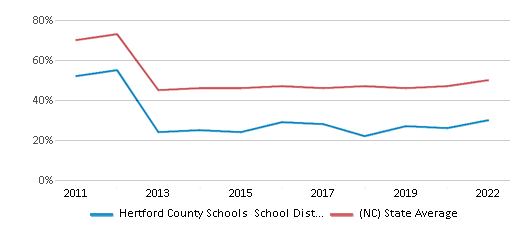
Science Test Scores (% Proficient)
37%
63%

Graduation Rate
75-79%
86%

Students by Ethnicity:
Diversity Score
0.39
0.69
# American Indian Students
14 Students
1,212 Students
% American Indian Students
1%
1%
# Asian Students
21 Students
6,451 Students
% Asian Students
1%
4%
# Hispanic Students
145 Students
20,765 Students
% Hispanic Students
6%
14%
# Black Students
1,892 Students
37,792 Students
% Black Students
77%
26%
# White Students
277 Students
68,361 Students
% White Students
11%
47%
# Hawaiian Students
16 Students
152 Students
% Hawaiian Students
1%
n/a
# Two or more races Students
80 Students
11,869 Students
% of Two or more races Students
3%
8%
Students by Grade:
# Students in PK Grade:
109
-
# Students in K Grade:
178
13,257
# Students in 1st Grade:
201
13,156
# Students in 2nd Grade:
159
13,157
# Students in 3rd Grade:
191
12,773
# Students in 4th Grade:
153
12,472
# Students in 5th Grade:
175
12,615
# Students in 6th Grade:
162
13,548
# Students in 7th Grade:
170
13,187
# Students in 8th Grade:
168
12,817
# Students in 9th Grade:
256
9,184
# Students in 10th Grade:
201
8,085
# Students in 11th Grade:
157
6,705
# Students in 12th Grade:
161
5,646
# Ungraded Students:
-
-
District Revenue and Spending
The revenue/student of $13,684 is higher than the state median of $11,187. The school district revenue/student has grown by 8% over four school years.
The school district's spending/student of $13,626 is higher than the state median of $11,612. The school district spending/student has grown by 8% over four school years.
Total Revenue
$33 MM
$17,307 MM
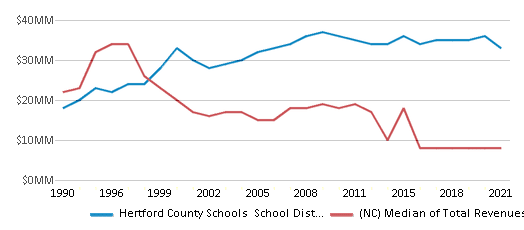
Spending
$33 MM
$17,964 MM
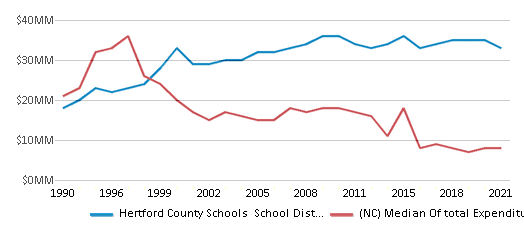
Revenue / Student
$13,684
$11,187
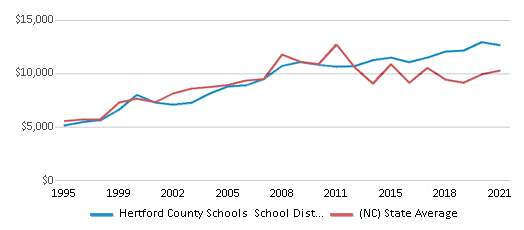
Spending / Student
$13,626
$11,612

Best Hertford County Schools School District ÎÛÎÛÂþ» Charter Schools (2025)
School
(Math and Reading Proficiency)
(Math and Reading Proficiency)
Location
Grades
Students
Rank: #11.
Charter School Brown High - Stem Program
Charter School
(Math: ≥50% | Reading: 21-39%)
Rank:
Rank:
4/
Bottom 50%10
102 Csb Dr
Winton, NC 27986
(252) 358-2852
Winton, NC 27986
(252) 358-2852
Grades: 9-12
| 73 students
Recent Articles

Year-Round Or Traditional Schedule?
Which is more appropriate for your child? A year-round attendance schedule or traditional schedule? We look at the pros and cons.

Why You Should Encourage Your Child to Join a Sports Team
Participating in team sports has a great many benefits for children, there is no doubt. In this article you will learn what those benefits are.

White Students are Now the Minority in U.S. ÎÛÎÛÂþ» Schools
Increasing birth rates among immigrant families from Asia and Central and South America, combined with lower birth rates among white families, means that for the first time in history, public school students in the United States are majority-minority. This shift in demographics poses difficulties for schools as they work to accommodate children of varying language abilities and socio-economic backgrounds.





